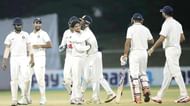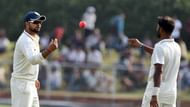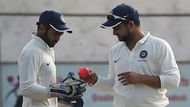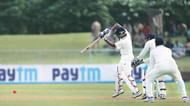India’s first ever FC match played with a pink ball under floodlights came to a conclusion on Friday, with Yuvraj Singh-led India Red claiming victory by 219 runs over India Green in the inaugural match of the 2016 Duleep Trophy.
The stars of the show were Abhinav Mukund and Kuldeep Yadav for India Red, while India Green captain Suresh Raina himself put up a brave effort in a losing cause, but the most of the attention was understandably on the pink ball.
The pink ball being still at a stage of experimentation, the results found from these Duleep Trophy matches is vital for the future of the day/night Tests in the country. It has been stressed by BCCI several times that an international Test will be hosted under lights in the country only if the findings from the Duleep Trophy matches are positive.
Fast bowlers prove unplayable in initial stages of match
As was seen in the CAB Super League final in June, and was repeated in the Duleep Trophy match, fast bowlers rule the roost in the first innings. 17 wickets fell on Day 1 of the Duleep Trophy match. Sandeep Sharma took 4 wickets for India Green, a feat bettered by Nathu Singh’s 6 wickets for India Red – the first FC 5 wicket haul in this new format on Indian soil.
Abhinav Mukund was the only batsman who settled in on the first day, finishing with a score of 77. The only other respectable scores on the day were Suresh Raina’s 35 and Saurabh Tiwary’s 50, as the pink ball seemed to find its way through the defence of all batsmen.
Similarly, in the CAB Super League final, 4 wickets had fallen in the first hour of the match, and Mohammed Shami’s first spell of the match had seen 7 wickets fall within an hour. For reasons of the degree of swing generated with the pink ball initially, or for reasons of batsmen being tentative in early stages faced with the new ball, fast bowlers seem to enter these matches with an air of invincibility.
However, the pink ball does not seem to get old like the red ball, and so reverse swing is taken out of the equation in the later stages of the bowling innings.
Less spin but lot of drift

A cover of 4mm grass was kept on the pitch of the Greater Noida stadium, and there was more grass cover on the rest of the surface of the ground as well, conforming to guidelines that excess grass needs to be kept in matches in which the pink ball will be used, because this ball is more susceptible to wear and tear. Despite there being more grass cover than in usual Indian grounds, it was less than the grass seen on the Eden Gardens pitch. Consequently, while spinners were used very frugally in the CAB Super League final, there were spinners on show in the Duleep Trophy match.
While the degree of turn on the pitch was not very much, a lot of the spinners got considerable drift and dip. Because the ball stays hard unlike the red ball which gets softer as play goes on, it is more difficult for spinners to extract turn. However, because the shine of the pink ball stays on, it tends to skid on to the stumps.
While Pragyan Ojha and Kuldeep Yadav claimed 3 wickets each in the first innings, there were two five wicket hauls for spinners in the 2nd innings – Kuldeep Yadav’s 6/88 and Shreyas Gopal’s 5/123.
Mukund lays claim to being Test opener
The one batsman who looked confident against the pink ball on Day 1 when everybody else looked clueless was Abhinav Mukund – forever to be remembered as the first centurion in FC cricket played with the pink ball in India.
Mukund, who had made it into the fringes of the India team back in 2011 as the reserve opener but has not been considered since, proved why he was once held in such high regard. Mukund scored a total of 246 runs in the match, the next highest cumulated runs over 2 innings was Suresh Raina’s 125.
Sudip Chatterjee also looked fluent during his stand with Mukund for India Red, scoring the only other century of the match. As for Mukund, it can be imagined that he will be looking to use this Duleep Trophy to return to the national team set up.
Contrasting fortunes for two captains Yuvraj and Raina

The two sides were led by two India greats Yuvraj Singh and Suresh Raina, who enjoyed disparate fortunes in the match. Yuvraj’s India Red won the match, but both his batting and his captaincy were found to have fault with. Suresh Raina, on the other hand, was on the losing side, but put up a brave fighting effort in both inings with the bat himself.
While Yuvraj managed scores of 4 and 10, Raina was among the highest scorers from his side in both innings. His 35 was the 2nd highest score from the first innings, but it was in the 2nd innings that his 90 infused a lot of excitement into the game. Even on the last day, with only the tail to bat with, Raina gave charge to Kuldeep and Nathu Singh, the most effective bowlers from India Red. He even produced a loft off the back foot played with a straight bat, showing batting prowess that he has often been criticised to be lacking.
Yuvraj Singh’s captaincy was found fault with on the final session of the match, as he let singles flow when it would have been more prudent to increase the pressure. However, this would not come back to bite Yuvraj as the margin of victory was the only thing left to be decided on the final day.
Pink ball retains shape and colour

The one big question mark on the use of the pink ball has been whether it will retain its shape and colour, with a lot of initial reports from Australia suggesting that it gets disfigured and impossible to spot as play goes on. The ball retained its shape perfectly in the CAB Super League final, but there had been an unusual amount of grass left on that ground.
With considerably less protection, the Greater Noida ground would test the durability of the pink ball. However, it was proved that all fears as to whether it would last were unfounded. Even on a dryish pitch, the ball retained its shape and did not lose its colour or shine.
Robin Uthappa, one of the batsmen involved in the match, gave the ball a resounding thumbs up, but came up with a suggestion that the ball be changed after every 60 overs instead of 80 to counter the fact that reverse swing is not possible. Such suggestions and ideas can be be given thought to, but it is clear that there is no reason why pink ball day night cricket cannot be a success in India.
Only question that remains – when do we see India playing an international team in this format?
Brand-new app in a brand-new avatar! Download CricRocket for fast cricket scores, rocket flicks, super notifications and much more! 🚀☄️

